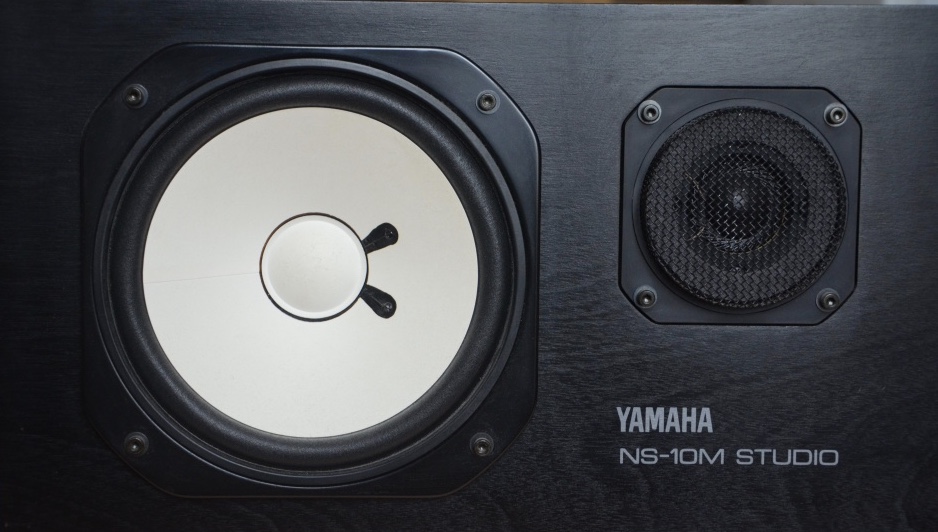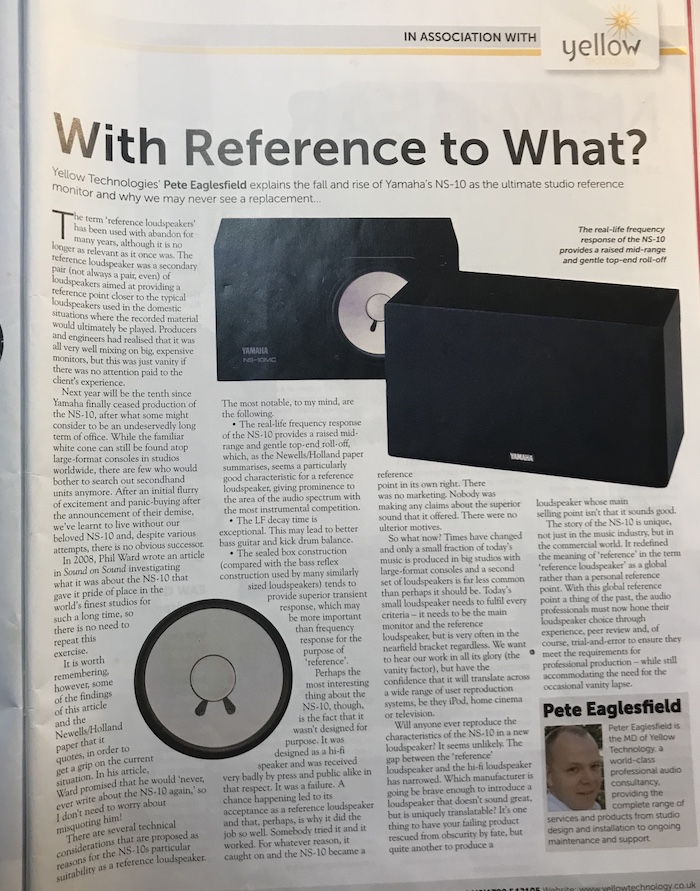A number of years ago our friends at Audio Pro International invited me to write an article on the rise & fall of the Yamaha NS-10… Yes, that studio ‘reference’ monitor that so many of us love to hate. The very same topic came up over our workshop this week and it still appears to be a matter of great debate. Perhaps we’ll continue it in these pages sometime soon, but to get the ball rolling here’s what I said about it the first time around!
The real-life frequency response of the NS-10 provides a raised mid-range and a gentle top-end roll off.
With Reference To What?
The term ‘Reference Loudspeakers’ has been used with abandon for many years and it is no longer as relevant as it once was. The reference loudspeaker was a secondary pair (not always a pair, even) of loudspeakers aimed at providing a reference point closer to the typical loudspeakers used in the domestic situations where the recorded material would ultimately be played. Producers and engineers had realised that it was all very well mixing on big, expensive monitors, but this was just vanity if there was no attention paid to the ‘end user’ experience.
It’s now 18 years since Yamaha finally ceased production of the NS-10, after what some might consider to be an undeservedly long term of office. Whilst the familiar white cone can still be found atop large-format consoles in studios worldwide, there are few who would bother to search out secondhand units any more. After an initial flurry of excitement and panic-buying after the announcement of their demise, we’ve learnt to live without our beloved NS-10 and, despite various attempts, there is no obvious successor.
‘With Reference to What?’ the first time around…
What was all the fuss about?
In 2008, Phil Ward wrote an excellent article in Sound on Sound investigating what it was about the NS-10 that gave it pride of place in the world’s finest studios for such a long time, so I don’t feel the need to repeat this exercise. However, it is worth remembering some of the findings of this article and the Newells/Holland paper that it quotes, in order to get a grip on the current situation. In his article, Phil promised that he would “never ever write about the NS-10 again”, so I don’t need to worry about misquoting him!
There are several technical considerations that are proposed as reasons for the NS-10’s particular suitability as a reference loudspeaker. The most notable, to my mind, are the following:
The real-life frequency response of the NS-10 provides a raised mid-range and gentle top-end roll-off, which, as the Newells/Holland paper summarises, seems a particularly good characteristic for a reference loudspeaker, giving prominence to the area of the audio spectrum where there is most instrumental competition.
The low frequency decay time is exceptional. This may well lead to an improved bass guitar and kick drum balance.
The sealed box construction (compared with the bass reflex construction used by many similar-sized loudspeakers) tends to provide superior transient response, which may be more important than frequency response for the purpose of ‘reference’.
A happy accident?
Perhaps the most interesting thing about the NS-10, though, is the fact that it wasn’t designed for purpose. It was designed as a hi-fi speaker and was received very badly by press and public alike in that respect. It was a failure. A chance happening led to its acceptance as a reference loudspeaker and that, perhaps, is why it did the job so well. Somebody tried it, and it worked. For whatever reason, it caught on and the NS-10 became a reference point in its own right. There was no marketing. Nobody was making any claims about the superior sound that it offered. There were no ulterior motives. It just came about.
So what now? Times have changed. Only a small fraction of today’s music is produced in big studios with large-format consoles, and a second set of loudspeakers is far less common than perhaps it should be. Today’s small loudspeaker needs to fulfill every criteria - it needs to be the main monitor and the reference loudspeaker, but is very often in the nearfield bracket regardless. We want to hear our work in all its glory (the vanity factor) but have the confidence that it will translate across a wide range of user reproduction systems, be they iPad, home cinema or television.
For future reference…
Will anyone ever reproduce the characteristics of the NS-10 in a new loudspeaker? It seems unlikely. The gap between the ‘reference’ loudspeaker and the hi-fi loudspeaker has narrowed. Which manufacturer is going be brave enough to introduce a loudspeaker that doesn’t sound great but is uniquely translatable? It’s one thing to have your failing product rescued from obscurity by fate, but quite another to produce a loudspeaker whose main selling point isn’t that it sounds good!
The story of the NS-10 is unique, not just in the music industry but in the commercial world. It redefined the meaning of ‘reference’ in the term ‘reference loudspeaker’ as a global rather than a personal reference point. With this global reference point a thing of the past, the audio professional must now hone their loudspeaker choice through experience, peer review and, of course, trial-and-error to ensure they meet the requirements for professional production - while still accommodating the need for the occasional vanity lapse.




